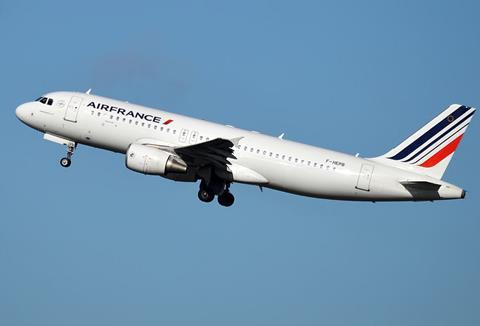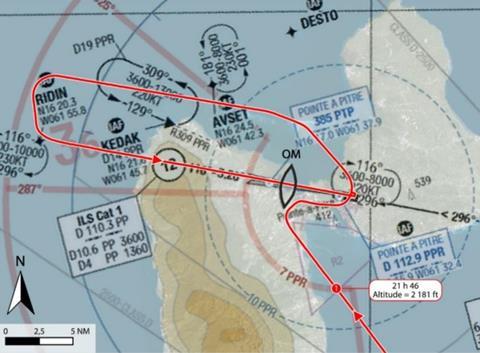French investigators believe an Airbus A320 pilot manually flew a visual approach with too much bank, and lost sight of the airport, before descending on a flightpath which was far offset from the runway centreline in Guadeloupe.
The Air France aircraft was inbound from Martinique at night on 11 February last year.
Its captain opted against vectoring for the ILS to Pointe-a-Pitre’s runway 12, requesting to fly a visual approach instead.
This required the aircraft, which was flying a northwest heading, to carry out a substantial right turn in order to align with the runway.
French investigation authority BEA states that the captain disengaged the autothrottle and autopilot and started the turn 15s later, abeam the runway, at around 2,000ft.
But the presence of a few areas of cloud meant the captain briefly lost sight of the runway. The aircraft’s bank, initially 15°, increased to 28° and this tighter turn, combined with a wind from the northeast, meant the aircraft rolled out on a course parallel to the runway but 1nm to the right.

The first officer had been pre-occupied with tasks including extending the landing-gear and flaps, arming the spoilers, turning on lights, and making a passenger announcement.
“[His] workload did not allow [the first officer] to sufficiently monitor the trajectory,” says BEA.
As the aircraft’s bank increased, it descent rate increased to 1,570ft/min and more than 2,000ft/min a few seconds later.
By the time it had turned to a heading of 100° it had descended to an altitude of 1,100ft, triggering a warning at the air traffic control tower. The controller, who was clearing the aircraft to land, immediately instructed the crew to check their height.
The crew read back the landing clearance, and the controller again mentioned the altitude alarm.
BEA says the crew then realised the aircraft was not following the runway centreline, and aborted the approach. The jet had descended to 460ft while some 2.5nm from the runway threshold.
During the go-around the A320’s minimum speed was 128kt compared with the approach reference speed of 138kt. The crew subsequently conducted an ILS approach to runway 12 and landed without further incident.

Cockpit-voice recorder information was not available to the investigators.
But the captain told the inquiry that he had been looking for a lit runway, which a curtain of rain had hidden, but still had visual contact with the ground and thought he recognised characteristic ground references. He did not refer to his navigation display.
“When he levelled the wings, he did not see the runway in front of him,” says BEA.
The first officer, upon hearing the warning from the controller, checked the aircraft’s altimeter settings but observed on his own navigation display that the aircraft was not on the approach axis. He also noticed that the captain’s navigation display was set at a longer 20nm range.
BEA says the crew testified to having taken steps to identify and limit the risks of a night visual approach, including using the navigation display for terrain awareness.
It points out that, over the course of 2020-22, five Air France flights were the subject of safe-altitude alerts during visual approaches to Pointe-a-Pitre at night. Four of these occurred with the aircraft turning with “significant” vertical speed.
Air France issued a recommendation in 2021 that pilots should exercise “strict monitoring” of the vertical speed during the turn.
The carrier has since reinforced safety measures for the visual approach at night, insisting that at least one pilot must have prior experience of conducting it.
Loss of visual contact with the airport, even temporarily, must prompt an immediate go-around, it adds. Crews should also use the autothrottle to manage speeds, freeing the monitoring pilot to carry out other tasks.


























